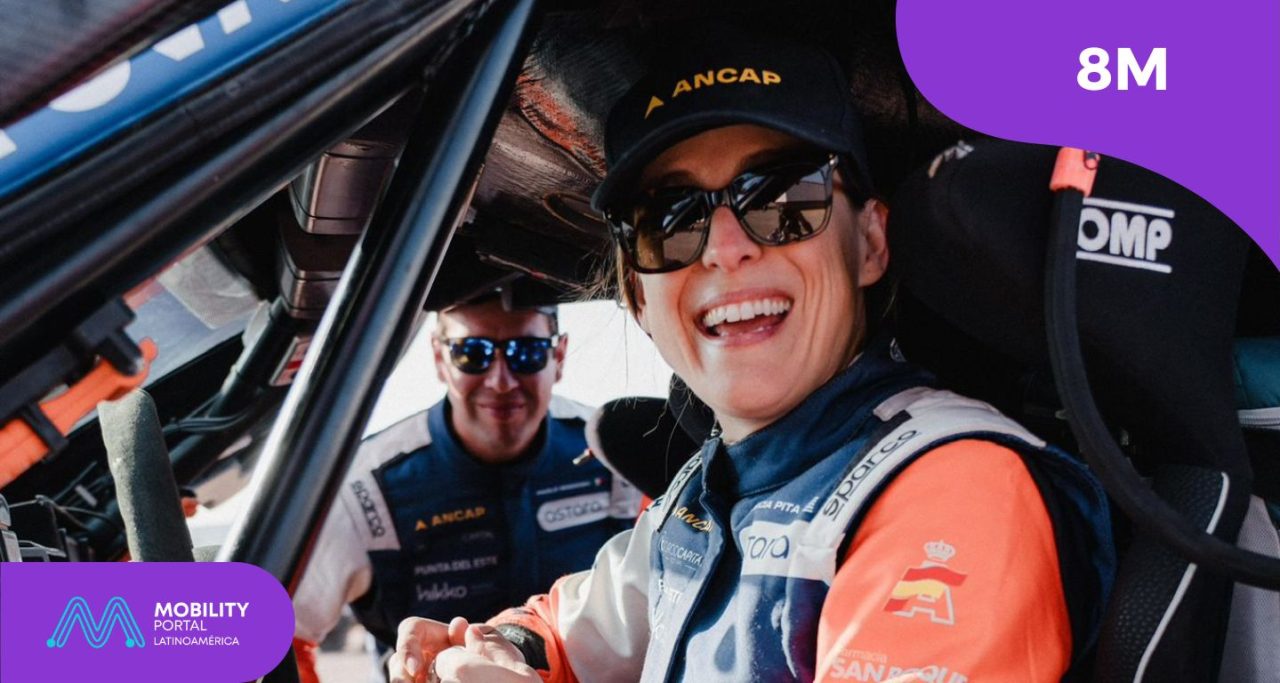This story begins with a girl immersed in the world of rally racing in Uruguay.
Her father, Jorge Pita, a legendary race car driver, and her mother, Luz Gago, dedicated to social work for over 20 years in an NGO fighting for the rights of women and girls worldwide, were the inspiration for triggering the chain of events that shaped her life.

Patricia “Pato” Pita grew up surrounded by cars and gradually shaped her passion.
Thus, amidst travels in the family’s Renault 18, providing remote assistance to her father, and jotting down competition times on sheets with her mother, she managed to become Uruguay’s first female rally driver and the first Uruguayan to participate in the Dakar Rally.
“Since I was little, I witnessed how my dad would get out of the car with passion and an adrenaline rush. I wanted to be like him, to feel what he felt behind the wheel,” she shares in a conversation with Mobility Portal Latinoamérica.
In a sport historically dominated by men, she breaks stereotypes and stigmas in many ways.
Not only did she establish herself as one of the few Latin American female drivers in the last Dakar edition, but she also did it aboard a hydrogen-powered vehicle.
“My mum always made it clear to me that my gender shouldn’t dictate my dreams,” she proudly asserts, highlighting that one of the main disadvantages women face in motorsports is the lack of incentives to start racing at an early age.
That’s why the Uruguayan, hailing from Maldonado, started participating in competitions only at the age of 24, with many fewer practice hours than her male counterparts and a car lent to her by her uncle.
That foundational gesture led her to experience firsthand the same emotions her father felt while racing: “I finished the last stretch and felt like the world disappeared, as if I were floating. At that moment, I realized I wanted to make a living out of this.”
After winning that competition, gaining experience, and racing for two years in Uruguay, Pita decided to move to Córdoba, Argentina, considered the cradle of rally racing due to its mountainous terrain.
“I faced many complications because I was a woman. It was two tough years, with a lot of pressure. Many underestimated me; I had to earn my place and prove that I deserved to be there,” she explains, while emphasizing that the support from her mother and her environment was crucial in facing inequalities.
What’s it like to participate in the Dakar as a woman?
Although year after year, the presence of women in the world’s most demanding competition is increasing, they still remain a minority.
The last Dakar reached a record number of participants, with a total of 778 between drivers and co-drivers.
Pato Pita was one of the 46 women who took part in the rally over 12 stages, representing almost six per cent of the total participants.
“It was tough for me to reach the Rally Dakar because I come from a hardworking, middle-class family, and the budgets are insane,” she comments on her experience in the last two editions.
To achieve her goal, Pita ran crowdfunding campaigns and even sold raffles.
“It was the first time a woman from Uruguay participated in the competition, and that raised many doubts in companies. A month before registration, I only had one sponsor, but I always remained firm in my conviction,” she says.

This year, the Uruguayan received the call from Astara Team to form a team that respects the environment and diversity aboard a hydrogen-based vehicle.
She did it in category T1.2, at the wheel of Astara 02, a vehicle powered by synthetic fuel and the lightest in its category, weighing only 1,580 kilograms.
This decision marked a before and after in terms of sustainability, as unlike the rest of the traditional vehicles, her journey through the competition alongside Chilean Paolo Boggini left a zero carbon footprint.
“We’re at a turning point now. Synthetic fuels and electric mobility are the future. We must take care of the planet,” she reflects.
During their participation in the 46th edition, the Astara Team managed to save 13.25 tons of CO2, which is equivalent to the emissions generated by covering approximately 100,000 kilometers.
“We were the first team with two female leaders. They bet for the first time on a Latin American woman and a European, Laia Sanz. That sends a very powerful message. A team assembled with many nationalities,” she says about Astara’s vision.
Although she didn’t manage to overcome the first stage due to damage to her vehicle during the journey, she considers them “opportunities to improve” and to convey to future generations “the relevance of the process.”
Far from giving up, she is already preparing for her participation in the Dakar 2025 and confirms that she will do it with a zero-emission vehicle.
The importance of building female role models
“I grew up without female role models in the world of rally racing. My idols were my dad and his idols,” she recalls when discussing her impact on younger generations.
While she was focused on gaining experience and credibility in a male-dominated environment, many girls and teenagers began to see her as an inspiration.
In the world of rally racing, there are still many aspects to work on to achieve gender parity.
“We need to create more spaces, and that doesn’t depend so much on women. In the major categories of the world, there are no women. There are none in Formula 1, in the World Rally Championship, or in the World Touring Car Championship,” she clarifies.
Furthermore, she believes that education is the foundation for addressing these issues and for motorsport to be considered a sport without gender distinction.
That’s why she is clear about it: “All women who participate in this sport are an example for girls who want to be racers.”







